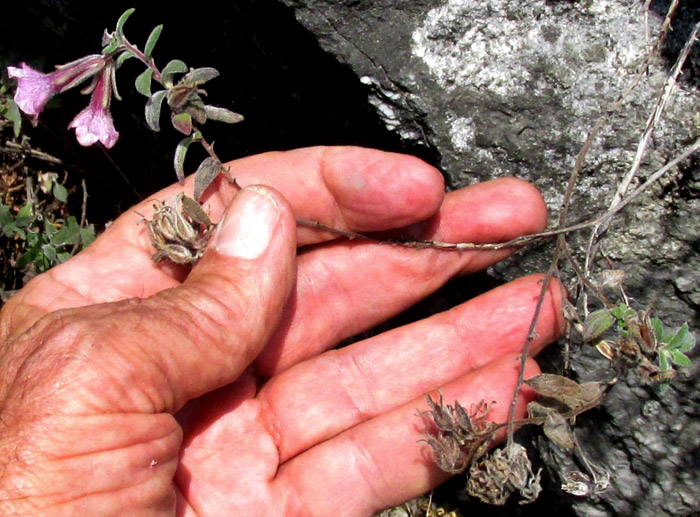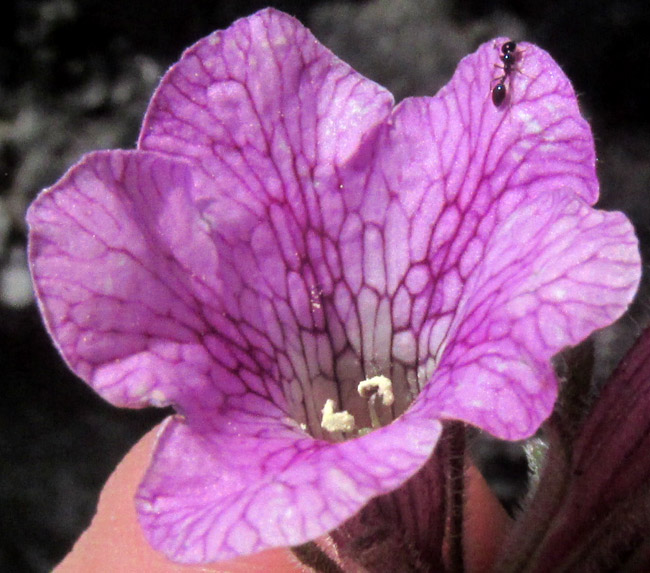Excerpts from Jim Conrad's
Naturalist Newsletter
entry from field notes dated May 4, 2023, taken about 150m uphill on NE-facing slope, above intersection of road from Hwy 120 to San Joaquín, with road to El Doctor; juniper and pine forest on limestone bedrock; elevation ±2425m (7950 ft); Eastern Sierra Madre mountains of east-central Querétaro state, MÉXICO, (N20.88°, W99.62°)
FIDDLELEAF, NAMA SERICEA

The above wildflower, mostly leafless at the end of an exceptionally long, rainless dry season, still had the vitality to flower and issue new leaves from its home in a crack at the base of a high limestone wall. At first it didn't look like anything I'd seen so the first step in "doing the botany" was to notice that leaves arose singly at stem nodes, not opposite one another. Next was to figure out how the flowers were arranged in their inflorescence:

As seen above, both the purple flowers and the old, dried-out flowering heads at the picture's lower left, inflorescences arose at stem tips, not along the stems' sides.

Up close, the corollas were particularly attractive with their dark purple, reticulating network of veins. Two of five anthers are seen emerging from the corolla's mouth, split open and releasing white, grainy pollen. Moreover, the anthers are "dorsifixed" -- attached at their backs to their stalk-like filament below. Sometimes that's a good field mark, for many flower groups attach their stamens at the base, or otherwise. This was all noteworthy, but still I had no solid hint as to the plant's identity.

Viewed from the side, at last something jigged my memory. The general dense, white hairiness on both the corollas and calyxes, and the calyxes' exceptionally slender sepals joining only at their bases, was very like a fiddleleaf species we met last year. That similarly hairy plant, also flowering in May, and also growing from cracks in rocks produced smaller flowers with white corollas, but the blossoms' sepals were shaped the same, and the corollas were similarly hairy outside. You can see this similar plant on our Nama origanifolium page. The best bet now was that we had another Nama.


Our limestone wall plant was densely hairy with soft, slender, white hairs, a kind of hairiness said to be "sericeous." The above shows the hairs on a leaf's undersurface. The hairs don't branch and their tips don't bear glands. At the right a stem also is hairy.
There's no treatment of the genus Nama for our part of the world, and there's even disagreement about whether the genus belongs to the Borage Family, the Boraginaceae, or deserves its own family, the Namaceae. Currently, Kew's Plants of the World database assigns it to the Borage Family. Whatever its family, by using various sources, eventually our plant revealed itself as NAMA SERICEA.
Nama sericea is endemic just to Mexico, from the northeastern uplands to upland Icentral Mexico. It bears no English name, though all members of the genus Nama can be called fiddleleafs, if not simply namas.
All the 50 or so Nama species are native to the Americas, and the Hawaiian Islands. Among those species our Nama sericea distinguishes itself with its relatively very large corolla, and its stiff, brittle stems which tend to recline or lie on the ground, when ground is available. Our plant dangled.
I find no literature mentioning human uses of Nama sericea -- little more than a few mentions of it documented as existing in certain areas. However, it does satisfy seekers of nectar and pollen, does spew out life-giving oxygen every hour of the day, and in the end generously returns the nutrients its borrowed to all other organisms who might want to use them.